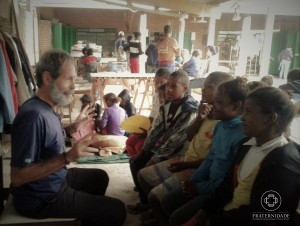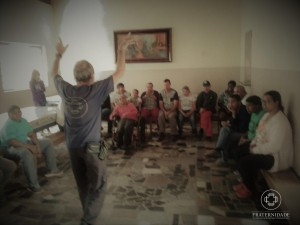On Sunday the 23rd, the missionaries of the Fraternity – International Humanitarian Federation (FIHF) participated via internet in the second class of the course on Story Telling, administered by Laerte, also a missionary.
- Laerte administering the Course on The Telling of Stories via internet
- Carmo da Cachoeira Mission – Missionaries’ Depot (2019)
One of the objectives of the course is to offer the missionaries another resource, since according to Laerte, “the task of the missionaries demands constant practice in communication, and the Story Telling is really a way of our paying attention to the way people are, in their behavior.”
“I felt it was a tool that can be very useful in the missions. Laerte taught it very well, showing how story telling can be well used,” says Boris, one of the participants in the course who is active in the Roraima Mission. Laerte points out that “the course of the Story Telling does not teach something new. It simple encourages us to remember something that we don’t value. All human beings, in all periods, told stories. What we do is to encourage rediscovering something forgotten.”
- Carmo da Cachoeira Mission – APAE (2019)
- Carmo da Cachoeira Mission – APAE (2019)
That simplicity, added to the teaching skills of Laerte, was also recognized by the missionary Sarah: “The methods Laerte uses are very down-to-earth and applicable. I could see the logical reasoning necessary for the plots used for different ages.”
Considering the importance of the practice of telling a story, Laerte affirms: “Storytelling is an art that preserves and transmits cultural values, and is very important in childhood development. Besides being an act of caring on the part of the adult, it is a recognition that the child can learn a lot through the stories, fables and fairy tales, in a playful and imaginative way.”
- Roraima Mission – Child describing a story about the colors of the rainbow.
- Roraima Mission – Child describing a story about the colors of the rainbow.
- Missionaries tell stories during educational activities.
Boris re-affirms the importance of this activity for children, and emphasizes: “In a story, not only ideas can be expressed, but also emotions, feelings; it is also educational, passing on ethical principles. Within a human context, to tell a story is a wonderful tool, for example, for helping children that may have some trauma.”
With a lot of new ideas and encouraged to continue, Boris says that “the native communities have their own stories and we can establish a bridge between the grandparents and the children. I feel that we must continue and deepen this course.”
Concerning the Missions and the art of storytelling, Laerte repeats: “Within the context of emergencies and human crises, where the missions are carried out, there are many people that leave their lives, their histories, and their countries behind. The Missionaries that take them in can be role models for them of how to rebuild their lives. Indirectly, through love, caring and attention, they receive the codes to re-invent their own stories.”
- Roraima Mission – Missionary telling stories during the Week of the Refugee
- Roraima Mission – Missionary telling stories during the Week of the Refugee
- Roraima Mission – Missionary telling stories during the Week of the Refugee
It was exactly that impression of love that Laerte managed to pass on in the classroom, according to what Sarah gauged: “Laerte used strategies of the African culture to tell stories. These have many elements of nature, that with their simplicity, make the story magnificent. One rather unexplainable aspect, but very explicit for the heart, was the love and care he emanates as he tells stories! For me, that was very special.”
The course will continue to make it possible for the missionaries to have that experience of love, which touches the heart, and the storytelling will delight many children and adults in the shelters and in all the Missions.


Roraima Mission (ATM) – Storytelling and working with body expression
















